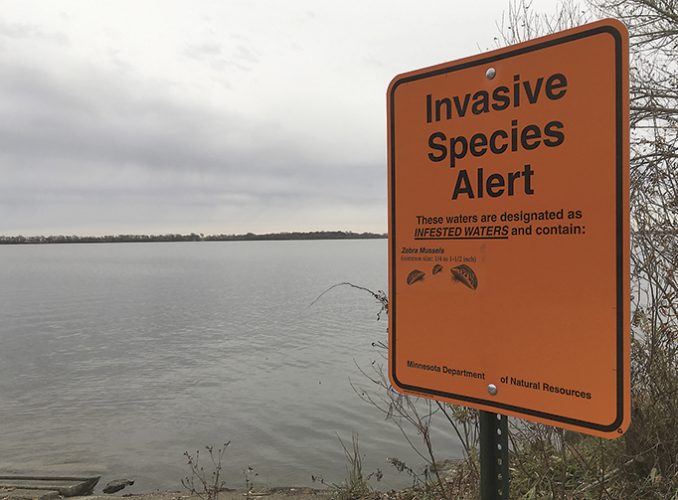
Recent discovery of Zebra Mussels raises awareness on popular lake
By Per Peterson
Dennis Moore fondly remembers fishing for bullheads on Lake Sarah in the early 1950s. Today, he is disheartened at the thought of his beloved lake — not to mention one of the more productive walleye lakes in the southern half of the state — being home to an aquatic enemy.
Moore lives in Redwood Falls but has a long history in the Tracy area. He owns 100-plus acres of land on the north side of Lake Sarah, and reacted to the recent news of the discovery of zebra mussels there with sadness.
“For me, I have not seen evidence of it — I have not seen it on trees that have fallen into the lake on our side of the lake, and we’ve had a couple of logs that came up that I looked at and didn’t find anything,” Moore said. “It’s very sad that we have zebra mussels.”
The DNR last week confirmed zebra mussels in the lake after Randy Martin, manager of Shetek Marine, discovered the Aquatic Invasive Species on a small number of lifts on October 17. The DNR said staff surveyed six locations around the lake and found multiple adult zebra mussels at all six locations. The DNR said it plans to bring in a conservation officer with a K9 trained to locate zebra mussels to search other equipment.
“They were all on the lifts that we were pulling out of the lake; they were big ones, too,” Martin said of the zebra mussels, which are microscopic “veligers” at birth that eventually form shells. “There were a handful to a dozen I would say on each lift. I was very surprised. You think it’s going to happen sooner or later, but at the same time we’re in our own little bubble out here and we think we’re immune to it.”
“Randy did a great job,” said Allison Gamble, invasive species specialist with the DNR’s Ecological and Water Resources Division. “He noticed something out of the ordinary and was proactive, decontaminating all the equipment that same day. He did everything we hoped for.”
Martin said lake service providers like himself and all the employees at Shetek Marine are mandated to undergo Aquatic Invasive Species (AIS) training every three years. All of the vehicles they use must also have a sticker on them, showing the training has been completed. Part of that training includes what to do if an AIS is spotted.
“We called the DNR right away so they can get their wheels in motion,” Martin said. “I called our local conservation officer and they called the AIS specialist.”
Martin said all the equipment and gear that was used the day the zebra mussels were found was specially cleaned.
“It all went in a special Lake Sarah pile,” he said. “We pressure-washed everything. We’ve never had such a clean barge.”
Gamble said zebra mussels are a tough problem to solve and pose a threat to all lakes because of their ability to reproduce and ability to thrive in a variety of surroundings.
“The females are capable to producing about up to one-half million babies,” gamble said. “Another characteristic is, in general, they’re very flexible as far as the range of conditions they can survive in. Duluth’s Superior Harbor is obviously a very different kind of system than Lake Sarah — they’re not a specialized animal that needs very specific conditions to live in.”
So what kind of damage can zebra mussels inflict on a lake? Their unrestricted growth combined with their ability to survive anywhere under any kinds of water even more effectively than a lake’s native mussels can make them more than a nuisance. Zebra mussels suck water into their bodies and can filter one quart of water per day while feeding mostly on algae, which is food for very young fish. Zebra mussels have the ability to “change where the energy is in a lake and move a lot of that food energy down to the bottom of a lake,” Gamble said. “That means less available food for the things people tend to care more about.”
For more on this article, see this week’s Headlight-Herald.
